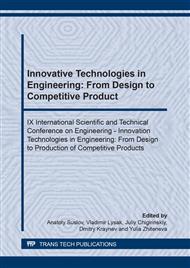[1]
A.I. Isayev, Surface microgeometry while turning: textbook, Moscow: Publishing House of the Science Academy of the USSR, (1950).
Google Scholar
[2]
V.K. Starkov, Physics and optimization of cutting materials, Мoscow: Mashinostroenie Publ., (2009).
Google Scholar
[3]
G.I. Yepifanov, Solid State Physics: tutorial. – 2nd ed. revised and enlarged, Moscow: High School, (1977).
Google Scholar
[4]
V.G. Sorokin, M.A. Gervasyeva, Steels and alloys, Grade guide: reference book, Moscow: Intermet Engineering, 2001, p.608.
Google Scholar
[5]
A.M. Sulima, Surface layer and operational properties of machine parts: textbook, Moscow: Mechanical Engineering, 1988, p.240.
Google Scholar
[6]
N.G. Zaytseva, A.R. Ingemansson, D.V. Kraynev, A.S. Sergeev, Problems of quality management while processing and modeling of the formation process of surface roughness in turning, News of VSTU: Progressive technologies in mechanical engineering, Issue 8: Interuniversity collection of scientific articles of VSTU, Volgograd, № 13:100 (2012), 15-18.
Google Scholar
[7]
A.L. Plotnikov, A.S. Sergeev, N.G. Zaytseva, A.A. Zhdanov, A special type of contact interaction in the turning of corrosion-resistant steels, its effect on cutting forces and the quality of the treated surface, News of VSTU: Progressive technologies in mechanical engineering, Volgograd, 1:156 (2015), 33-40.
Google Scholar
[8]
A.S. Sergeev, A.L. Plotnikov, N.G. Zaytseva, Quality management of metal parts machining by face milling machines on automated machine tools, News of VSTU: Progressive technologies in mechanical engineering", Issue 8: Interuniversity collection of scientific articles of VSTU. Volgograd, 13:100 (2012), 54-56.
Google Scholar
[9]
N.G. Zaytseva, A.S. Sergeev, A.L. Plotnikov, Calculation of the surface roughness parameter in edge cutting machining of carbon steels on CNC machine tools, News of VSTU: Progressive technologies in mechanical engineering, Issue 9: Interuniversity collection of scientific articles of VSTU, Volgograd, 7:110 (2013), 86-89.
Google Scholar
[10]
A.L. Plotnikov, A.S. Sergeev, S.N. Valkovskiy, N.G. Zaytseva, The method of automated calculation of the cutting speed for corrosion-resistant steel turning with a high-speed steel cutting tool on CNC machines, News of VSTU: Progressive technologies in mechanical engineering, Volgograd, 7:110 (2013), 99-101.
Google Scholar
[11]
N.V. Talantov, Phisical basics of the tool's cutting, wear and break down, Мoscow: Mashinostroenie Publ., 1992, p.240.
Google Scholar
[12]
A.L. Plotnikov, Measuring method for the thermoelectric power of a tool – workpiece natural thermocouple, RF Patent 2117557, IPC 7 V23 V25 / 06, VSTU (1999).
Google Scholar


